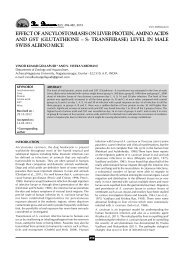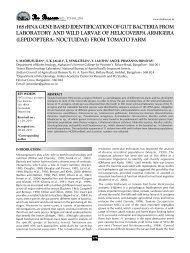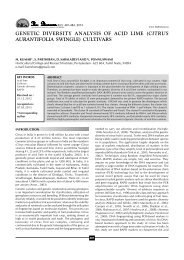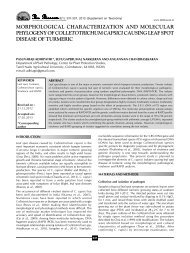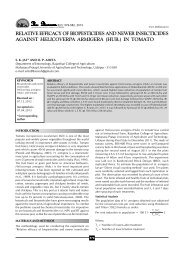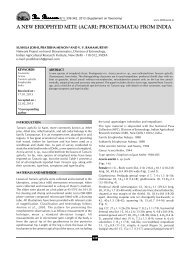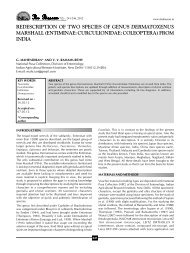fullpaper - THE BIOSCAN
fullpaper - THE BIOSCAN
fullpaper - THE BIOSCAN
Create successful ePaper yourself
Turn your PDF publications into a flip-book with our unique Google optimized e-Paper software.
BHANU PRATAP BHADAURIA et al.,<br />
pea, black gram, rajma, soybean, green gram, cow pea and<br />
pearl millet were used for estimating the sporution of B.<br />
bassiana, at 28ºC. 100g of each grain was washed and soaked<br />
in water overnight except rice which were soaked for 2 - 3h<br />
prior of starting the experiments. The excess water was drained<br />
by decanting and shade drying it for half an hour to further<br />
remove the excess moisture. The grains were packed separately<br />
in 500 mL conical flask, with cotton plug and auto calved at<br />
15 psi for 20 min. After cooling, 1 mL of the spore suspension<br />
of fungal pathogen was inoculated into each flask under<br />
laminar air flow chamber. They were incubated in BOD<br />
incubator at 28ºC for 15 days. Three replications were<br />
maintained for each grain. To avoid clumping, after 7 days of<br />
inoculation, the flasks were shaken vigorously to separate the<br />
grain and to break the mycelial mat. After 15 days of incubation,<br />
10g homogenous grain sample drawn from each replicate of<br />
uniformly sporulating flasks was transferred to 100 mL sterilized<br />
distilled water containing Tween 80 (0.05%) solution in 250<br />
mL conical flasks. The flasks were shaken in mechanical shaker<br />
for 10 min. The suspension was filtered through double layered<br />
muslin cloth. Counting of spore’s were made after the serial<br />
dilution of the suspension using double ruled Neubauer<br />
haemocytometer for determining the number of conidia in 1 g<br />
of the cereal grains.<br />
Liquid media: Potato Dextrose Broth and Sabouraud’s<br />
Dextrose Broth, were evaluated for the growth and sporulation<br />
of Beauveria bassiana fungi. 100 mL of each medium was<br />
poured in 250 mL capacity conical flasks and autoclaved at<br />
15 psi pressure for 30 min. Five flasks of each medium was<br />
inoculated with 1 mL of spore suspension of fungi separately<br />
and incubated at 28ºC for 15 days. The spore suspension<br />
was subjected to spore counting and it was carried out as<br />
described in the previous section.<br />
Statistical analysis: ANOVA was used to analyse the<br />
significance of temperature and media on sporulation of fungal<br />
pathogens using ‘STATISTICA’ computer package.<br />
RESULTS AND DISCUSSION<br />
Beauveria bassiana is an entomopathogenic fungus. The<br />
present experiments were conducted to find out morphological<br />
variation, growth patterns and suitable media for its mass<br />
production. Table 1 revealed that dry weight of Pantnagar<br />
isolate of B. bassiana varied from 0.0 g to 0.765g on different<br />
media. Growth of this isolate on liquid media indicated<br />
maximum dry matter production in pea broth followed by<br />
chickpea. Liquid media, SDB produced significantly higher<br />
spore production of test fungi. Biomass production of 0.69<br />
and 0.63 g was recorded in B. bassiana on SDB. Potato<br />
Dextrose Broth (PDB) also supported spore production of the<br />
fungus (Table 1). Dangar et al. (1999) also observed similar<br />
findings in Metarizhium anisepliae. They found that<br />
abundance of glucose and minerals in the coconut water may<br />
enhance the growth and spore production of fungi. Rice and<br />
wheat washed water also supported the growth and sporulation<br />
of test fungi. Patel et al. (1990) reported that the purified rice<br />
wash water gave the best spore count in M. anisepliae. No<br />
significant difference in dry matter production of the fungus<br />
was observed among solid media having wheat, paddy,<br />
sorghum, groundnut, lentil and black gram, separately.<br />
Table 1: Biomass production (g) and sporulation (x10 7 ) of Beauveria<br />
bassiana on various substrates<br />
S. No. Media Dry weight of Conidial count<br />
fungus (g) (10 7 mL -1 )<br />
1 Wheat 0.378 (0.936) 2.66 (1.76)<br />
2 Maize 0.238 (0.859) 2.33 (1.67)<br />
3 Paddy husk 0.383 (0.939) 3.33 (1.95)<br />
4 Sorghum 0.506 (1.003) 5.00 (2.34)<br />
5 Rice 0.555 (1.027) 7.60 (2.84)<br />
6 Groundnut 0.488 (0.994) 4.40 (2.21)<br />
7 Jhangora 0.000 (0.7071) 0.00 (0.70)<br />
8 Chickpea 0.701 (1.096) 6.40 (2.62)<br />
9 Lentil 0.629 (1.062) 7.60 (2.84)<br />
10 Pea 0.765 (1.124) 8.00 (2.91)<br />
11 Black gram 0.616 (1.056) 6.80 (2.70)<br />
12 Rajma 0.195 (0.833) 2.33 (1.67)<br />
13 Soybean 0.671 (1.082) 8.00 (2.91)<br />
14 Green gram 0.500 (0.999) 5.40 (2.42)<br />
15 Cowpea 0.652 (1.073) 9.06 (3.09)<br />
Liquid media<br />
16 SDB 0.696 (1.090) 6.53 (2.65)<br />
17 PDB 0.635 (1.060) 5.60 (2.47)<br />
CD at 5% 0.028 (0.014) 0.928 (0.211)<br />
* Parentheses values are square root transformed x + 0.5<br />
However, significant difference was observed in mycelia<br />
growth of fungus on SDB and PDB liquid media. Generally,<br />
higher dry matter production was observed on broth of pulses<br />
as compared to broths of cereals and oilseed. However, we<br />
widely used jhangora grains for the mass production of<br />
Trichoderma spp. as it is very cheap and easily available. In<br />
flasks having jhangora broth, due to the growth of undesireable<br />
fungi like Penicillium, Aspergillus, Mucor etc. no growth of<br />
B.bassiana was observed which indicate its non suitability for<br />
mass production of this fungus. Pilot studies using Jhangora<br />
grains will help to confirm these findings.<br />
Highest conidial count (9.06 × 10 7 conidia mL -1 ) was observed<br />
on cowpea media followed by soybean. Significant differences<br />
in conidial count were observed on maize, paddy, sorghum,<br />
rice and chickpea. Whereas, no significant difference was<br />
observed on the fungal growth among rice, lentil, pea and<br />
soybean added media. All the pulses along with wheat are<br />
known to have appreciable amounts of protein. Higher<br />
nitrogen has been shown to be necessary for mycelial growth<br />
of fungi (Riba and Glande, 1980; IM et al., 1988) which may<br />
be a reason for maximum production of biomass and conidia<br />
on Chickpea, pea, soybean etc. Most of these pulses and<br />
grains are part of human diet and their cultivation charges<br />
make them less economical for the mass multiplication of<br />
B.bassiana. Cheap culture medium is required in order to<br />
increase the cost-benefit ratio. Hence, several sources were<br />
tested for mass multiplication. Low cost sources of nutrients<br />
like millets such as sorghum, jhangora, and pearl millet were<br />
assessed for their utility in terms of conidial yield of the test<br />
fungus. Some of these grains are inexpensive, easily available<br />
and act as best nutritive media for the mass multiplication of<br />
many micro and macro organisms. Previously, Ibrahim and<br />
Low (1993) and Sharma et al. (2002) found rice as a suitable<br />
media for the mass culture of B. bassiana. This cereal was also<br />
used for the mass production of other deuteromycete fungi.<br />
Gopalakrishnan et al. (1999) reported that sorghum was the<br />
ideal cereal for the mass production of Paecilomyces farinosus,<br />
230



